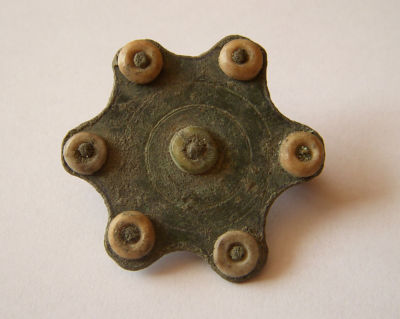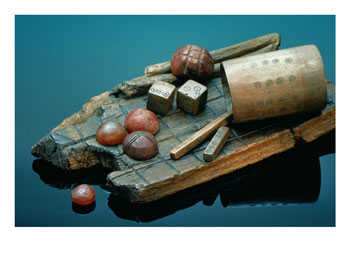It looks like you're using an Ad Blocker.
Please white-list or disable AboveTopSecret.com in your ad-blocking tool.
Thank you.
Some features of ATS will be disabled while you continue to use an ad-blocker.
share:

These fist-sized bronze Roman artifacts found in France, Switzerland and Germany pose a fascinating problem for archaeologists: they just don’t have a clear purpose, but many are covered in symbols, some undecipherable and others relating to the Zodiac. But for all the speculation on their use, including that they may have been surveying instruments, some experts believe the Roman dodecahedra were merely decorative candlesticks.
A Roman dodecahedron is a small hollow object made of bronze or stone, with a dodecahedral shape: twelve flat pentagonal faces, each having a circular hole in the middle which connects to the hollowed-out center. Roman dodecahedra date from the 2nd or 3rd centuries CE. About a hundred of these dodecahedra have been found from Wales to Hungary and to the east of Italy, with most found in Germany and France. Ranging from 4 cm to 11 cm in size, they also vary in terms of textures. Most of them are made of bronze but some also seem to be made of stone. The function or use of the dodecahedra is unknown; no mention of them has been found in contemporary accounts or pictures of the time. Speculated uses include candlestick holders (wax was found inside one example); dice; survey instruments; devices for determining the optimal sowing date for winter grain;[1] that they were used to calibrate water pipes; and army standard bases. It has also been suggested that they may have been religious artifacts of some kind. This latter speculation is based on the fact that most of the examples have been found in Gallo-Roman sites.
Very interesting objects indeed...I have never seen these before...Does anyone have anything to add as to what they think they were used for? IMO the theory that they were fancy candle holders is not the answer, it looks more like some sort of mapping tool or perhaps a piece of some instrument. The fact that they were made of different materials also adds to its mystery...from stone to metal...I love stuff like this...
Maybe they rolled it across the ground like a dice to tell someones fortune..
edit on 8/13/13 by shells4u because: (no reason given)
Interesting find OP. Never seen anything like it before but it doesn't look like a candle holder to me. Has more of the look of a directional device.
Perhaps the zodiac markings line up some way depending on the time of year giving you a compass like tool (without magnetics.)
Maybe it was an ancient form of "smart phone"?
You could find constellations, survey, play games (dice), light your home (flashlight app)...
Pretty neat looking, I think we've got another discussion on this somewhere here. Does anyone remember that one? I think ATS members were able to pull up more information on it.
You could find constellations, survey, play games (dice), light your home (flashlight app)...
Pretty neat looking, I think we've got another discussion on this somewhere here. Does anyone remember that one? I think ATS members were able to pull up more information on it.
reply to post by shells4u
Information on RD's
Link
Etruscan Dodecahedron
Discusses Gallo-Roman dodecahedrons
Report on RD's
Information on RD's
Link
Etruscan Dodecahedron
Discusses Gallo-Roman dodecahedrons
Report on RD's
It's a (fruit, xyz?, whatever?) measuring device, used by tradesmen to determine the price of (apples? potatoes? Etc.?)
Prices were set according to size. For example, when an apple fit through opening #5, it cost 5 dinars.
Of course I just made that up, but I seriously believe it had such a very practical purpose. Something was measured with it.
Prices were set according to size. For example, when an apple fit through opening #5, it cost 5 dinars.
Of course I just made that up, but I seriously believe it had such a very practical purpose. Something was measured with it.

Here is a stone polyhedral from the Roman period.
From the Roman twenty-sided die auctioned for $18k in 2008 (pictured above), to the discovery of pieces in the tombs of pharaohs in ancient Egypt
An archaeologist recently published a paper musing over the large amount of dice and playing pieces found in a 4500 year old city in Pakistan.
escapist magazine / Gamers Ruled Ancient City in Pakistan
Mike
edit on 13-8-2013 by mikegrouchy because: (no reason given)
edit on 13-8-2013 by mikegrouchy because: (no reason
given)

Here is another version of the dodecahedron.
Plutarch, the famous Greek historian reportedly identified the dodecahedron as a vital instrument for zodiac signs. The twelve sides represent the twelve animals in the circle of the Zodiac, but even this theory comes under contest when the argument of the knobs as decoration is presented.
They vary from 4 to 11 cm.
Mike
My own suspicion is that the knobs
were adorned with something made of Bone.

This example of a bronze and bone broach,
shows how the materials were combined in the ancient world.
Mike
were adorned with something made of Bone.

This example of a bronze and bone broach,
shows how the materials were combined in the ancient world.
Mike

Here is an Icosahedron version
with the faces intact.
8 cm diameter.
Mike
reply to post by mikegrouchy
That reminded me of a dungeons & dragons die.
(i'm a dork) but ewe knew that.
That reminded me of a dungeons & dragons die.
(i'm a dork) but ewe knew that.
reply to post by shells4u
Are we guessing? This object has five knobs upon which it can stand no matter which way it is placed on a table. There are twelve positions that coincide with the Roman calendar that switched to 12 months in a year in 700 BCE. In order to keep this new calender fresh in the minds of the citizens, these dodecahedra were designed so that the current month would be positioned at the top. How's that for a stretch of the imagination?
Are we guessing? This object has five knobs upon which it can stand no matter which way it is placed on a table. There are twelve positions that coincide with the Roman calendar that switched to 12 months in a year in 700 BCE. In order to keep this new calender fresh in the minds of the citizens, these dodecahedra were designed so that the current month would be positioned at the top. How's that for a stretch of the imagination?
reply to post by mikegrouchy
Thank you Mike for posting the pics and ideas...It seems there were quite a few of these and the last pic looks oriental to me.
Thank you Mike for posting the pics and ideas...It seems there were quite a few of these and the last pic looks oriental to me.
reply to post by jiggerj
There are twelve positions that coincide with the Roman calendar that switched to 12 months in a year in 700 BCE. In order to keep this new calender fresh in the minds of the citizens, these dodecahedra were designed so that the current month would be positioned at the top. How's that for a stretch of the imagination?
Good guess and even better description...I believe you might be right, sounds good to me....
Something very similar were used to create the sound of thunder in ancient mystery plays, they would roll it down plank to simulate the noise, but
some of these appear to be too ornate for such a task, making the calendar for some a more likely hypothesis.
Looks like some kind of incendiary shell.The standoffs make sure the shell continues to burn.
reply to post by shells4u
The number 12....
....perhaps it was a minor offering tool used for the 12 houses of the zodiac. You burn a candle with the candle protruding from the hold corresponding the the sign you are under (or praying to).
The number 12 is significant to whichever group/cult was using these, in my fair opinion.
The number 12....
....perhaps it was a minor offering tool used for the 12 houses of the zodiac. You burn a candle with the candle protruding from the hold corresponding the the sign you are under (or praying to).
The number 12 is significant to whichever group/cult was using these, in my fair opinion.
reply to post by bigfatfurrytexan
You burn a candle with the candle protruding from the hold corresponding the the sign you are under (or praying to).
That makes sense< I was wondering why it was mentioned in more than one artical that it was thought that they were used to hold candles, I didn't understand why they would think that but how you explained it that now makes sense...thanks for bringing that idea.
new topics
-
Australian PM says the quiet part out loud - "free speech is a threat to democratic dicourse"...?!
New World Order: 34 minutes ago -
Ireland VS Globalists
Social Issues and Civil Unrest: 1 hours ago -
Biden "Happy To Debate Trump"
Mainstream News: 1 hours ago -
RAAF airbase in Roswell, New Mexico is on fire
Aliens and UFOs: 1 hours ago -
What is the white pill?
Philosophy and Metaphysics: 3 hours ago -
Mike Pinder The Moody Blues R.I.P.
Music: 3 hours ago -
Putin, Russia and the Great Architects of the Universe
ATS Skunk Works: 7 hours ago -
A Warning to America: 25 Ways the US is Being Destroyed
New World Order: 11 hours ago
top topics
-
President BIDEN's FBI Raided Donald Trump's Florida Home for OBAMA-NORTH KOREA Documents.
Political Conspiracies: 17 hours ago, 35 flags -
A Warning to America: 25 Ways the US is Being Destroyed
New World Order: 11 hours ago, 20 flags -
Mike Pinder The Moody Blues R.I.P.
Music: 3 hours ago, 7 flags -
What is the white pill?
Philosophy and Metaphysics: 3 hours ago, 5 flags -
Biden "Happy To Debate Trump"
Mainstream News: 1 hours ago, 5 flags -
RAAF airbase in Roswell, New Mexico is on fire
Aliens and UFOs: 1 hours ago, 4 flags -
Australian PM says the quiet part out loud - "free speech is a threat to democratic dicourse"...?!
New World Order: 34 minutes ago, 4 flags -
Putin, Russia and the Great Architects of the Universe
ATS Skunk Works: 7 hours ago, 3 flags -
Ireland VS Globalists
Social Issues and Civil Unrest: 1 hours ago, 2 flags
active topics
-
Supreme Court Oral Arguments 4.25.2024 - Are PRESIDENTS IMMUNE From Later Being Prosecuted.
Above Politics • 94 • : network dude -
-@TH3WH17ERABB17- -Q- ---TIME TO SHOW THE WORLD--- -Part- --44--
Dissecting Disinformation • 695 • : Thoughtful3 -
President BIDEN's FBI Raided Donald Trump's Florida Home for OBAMA-NORTH KOREA Documents.
Political Conspiracies • 32 • : network dude -
Ireland VS Globalists
Social Issues and Civil Unrest • 5 • : AllisVibration -
Massachusetts Drag Queen Leads Young Kids in Free Palestine Chant
Social Issues and Civil Unrest • 20 • : Oldcarpy2 -
Australian PM says the quiet part out loud - "free speech is a threat to democratic dicourse"...?!
New World Order • 2 • : ColeYounger2 -
Biden "Happy To Debate Trump"
Mainstream News • 23 • : NormalBates69 -
Starburst galaxy M82 - Webb Vs Hubble
Space Exploration • 10 • : LSU2018 -
Putin, Russia and the Great Architects of the Universe
ATS Skunk Works • 24 • : Oldcarpy2 -
Gaza Terrorists Attack US Humanitarian Pier During Construction
Middle East Issues • 81 • : KrustyKrab

